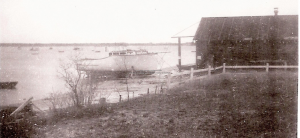Catch of the Day – Part 3
By Bruce Thurlow
Images from Scarborough Historical Society, Bruce Thurlow, Bill Bayley and Don Googins
Lobster Fishing
The first recorded lobster catch was in 1605 when the crew of the Archangel, captained by George Waymouth, set a small fishing net near Monhegan Island and hauled up a net filled with various fish and “thirty very good and great lobsters.” In the 1600s and 1700s, lobsters were easily harvested from tidal pools along the shoreline. So plentiful were lobsters that Native-Americans used them for crop fertilizer and fish bait, as well as food for themselves; early settlers considered lobsters food for servants and paupers. Some indentured servants in Massachusetts had written in their contracts that they should not be served lobster more than three times a week
Lobster fishing is still done in much the same way as when the fishery began, with some modern technology to make it easier. Lobsters are fished with baited traps or pots and the traps are dropped from a boat or “set.” Traps are attached by rope to a floating buoy to mark their location. To identify his traps, each lobsterman has his own buoy colors and markings. Sometimes traps are strung together and marked by a single buoy; this is called a trawl or a string. As weather permits, traps are hauled up one to five days later. Originally, hauling was done by hand using a gaff (a stick with a hooked end) to hook the buoy and pull up its rope. Now the rope is typically placed over a roller powered by a hydraulic hauler that pulls a trap up from the ocean floor. A lobsterman is able to pull many more traps in a day using the latter method. Once on deck, the trap is emptied. Hopefully, the trap contains lobsters, but there may also be other sea creatures and seaweed as well. Legal lobsters are transferred to a holding tank on the boat, and those lobsters above or below the designated legal size or those carrying eggs or a V-notch (indicating females capable of bearing eggs) are returned to the water. The trap is re-baited and reset until the next haul.
Lobster fishing was essentially a local industry until the introduction of the lobster “smack” in the early 1800s. A smack was a small sailing vessel with an open holding well with holes drilled into it to allow circulation of seawater. Smacks could transport live lobsters over longer distances to markets in Boston and New York. In response to a demand for lobster that exceeded the range of smack boats, companies such as Burnham & Morrill began canning lobster meat.
The first tidal lobster pound was introduced in Vinalhaven in 1875 and others quickly followed. Lobster pounds were much like smack boats; lobsters were held in tanks with circulating seawater. A lobster pound allowed a dealer to hold lobsters for future sale or a newly molted lobster time to harden its shell.
Various types of boats have been used by lobstermen through the years—sloops, smacks, dories, and skiffs. The peapod was a large double-ended skiff later adapted for use with an outboard motor. By 1910 engines began replacing sails and oars in lobster boats. Eventually, lobster boats of about 26 feet in length were designed with inboard engines. Use of gasoline or diesel engines enabled lobstermen to fish further along the coast or offshore or finish hauling early enough to undertake a second fishing-related job such as fishing for shrimp or dragging for hen clams.
Toward the end of the 1800s, the lobster stock seemed to be in decline, spurring the enactment of laws to protect and conserve the lobster population. In 1872 a law was passed banning the taking of egg-bearing females, a conservation measure already practiced by many Maine lobstermen, and in 1874 the first laws regulating the minimum size of lobsters were enacted. The minimum size deemed legal has changed over time and there is now a maximum size allowable. Lobstermen use a special gauge to determine which lobsters may be legally kept. Licenses are required and the number must appear on traps and buoys. There is also a law making it illegal for anyone to touch a labeled trap or buoy other than its owner.



